Little Wonder 8293-04-01, 8295-04-01 Owner's manual
- Type
- Owner's manual

MODELS:
8293-04-01
29HP SKID MOUNT TRUCKLOADER
8295-04-01
29HP TOW BEHIND TRUCKLOADER
PARTS / OPERATOR’S MANUAL
MAN 100103
Rev. C 10-2015
Original Language Instructions

CALIFORNIA
Proposition 65 Warning
Diesel engine exhaust and some
of its constituents are known to the
State of California to cause cancer,
birth defects and other reproductive
harm.
WARNING
The engine exhaust from this product
contains chemicals known to the State
of California to cause cancer, birth
defects or other reproductive harm.
CALIFORNIA
Proposition 65 Warning
Battery posts, terminals, wiring
insulation, and related accessories
contain lead and lead compounds,
chemicals known to the State of
California to cause cancer and birth
defects or other reproductive harm.
WASH HANDS AFTER HANDLING.

1
TRUCKLOADER
IMPORTANT MESSAGE
On behalf of everyone at Little Wonder, we would like to thank you for your purchase of a Little Wonder Truckloader.
This professional truckloader was designed to the highest standards to ensure many hours of uninterrupted service.
This machine comes with an Operators / Parts Manual. The useful life and good service you receive from this machine
depends to a large extent on how well you read and understand this manual. Treat your machine properly, lubricate and
adjust it as instructed, and it will give you many years of reliable service.
Your safe use of this Little Wonder product is one of our prime design objectives. Many safety features are built in, but we also
rely on your good sense and care to achieve accident-free operation. For best protection, study the manual thoroughly. Learn
the proper operation of all controls. Observe all safety precautions. Follow all instructions and warnings. Do not remove or
defeat any safety features. Make sure those who operate this machine are as well informed and careful in its use as you are.
See a Little Wonder dealer for any service or parts needed. Little Wonder service ensures that you continue to receive
the best results possible from Little Wonder products. You can trust Little Wonder replacement parts because they are
manufactured with the same high precision and quality as the original parts.
Little Wonder designs and builds its equipment to serve many years in a safe and productive manner. For longest life,
use this machine only as directed in the manuals, keep it in good repair and follow safety warnings and instructions. You'll
always be glad you did.
Little Wonder
1028 Street Rd.
Southampton, PA 18966
07-2014
TABLE OF CONTENTS FIGURES PAGE
SAFETY ......................................................................................................................................................... 2-6
LABELS ............................................................................................................................................................ 7
SET-UP INSTRUCTIONS ............................................................................................................................ 8-10
CONTROLS .................................................................................................................................................... 11
OPERATION ..............................................................................................................................................12-13
TRANSPORTATION ....................................................................................................................................... 14
MAINTENANCE / STORAGE ......................................................................................................................... 15
SPECIFICATIONS .......................................................................................................................................... 16
PARTS SECTION ......................................................................................................................................17-21
WARRANTY ............................................................................................................................... BACK COVER

2
TRUCKLOADER
MODEL NUMBER: This number appears on
sales literature, technical manuals and price lists.
SERIAL NUMBER: This number appears only
on your unit. It contains the model number
followed consecutively by the serial number.
Use this number when ordering parts or seeking
warranty information.
Schiller Grounds Care, Inc.
1028 Street Road
Southampton, PA 18966 U.S.A
Phone: 215-357-5110
Fax: 215-357-8045
MODEL NUMBER
SERIA
L NUMBER
SAFETY
NOTICE !!!
Unauthorized modications may present extreme
safety hazards to operators and bystanders and
could also result in product damage.
Little Wonder strongly warns against, rejects and
disclaims any modications, add-on accessories or
product alterations that are not designed, developed,
tested and approved by Little Wonder Engineering
Department. Any Little Wonder product that is altered,
modied or changed in any manner not specically
authorized after original manufacture–including the
addition of “aftermarket” accessories or component
parts not specically approved by Little Wonder–will
result in the Little Wonder warranty being voided.
Any and all liability for personal injury and/or property
damage caused by any unauthorized modications,
add-on accessories or products not approved by
Little Wonder will be considered the responsibility
of the individual(s) or company designing and/or
making such changes. Little Wonder will vigorously
pursue full indemnication and costs from any party
responsible for such unauthorized post-manufacture
modications and/or accessories should personal
injury and/or property damage result.
This symbol means:
ATTENTION!
BECOME ALERT!
Your safety and the safety of others is involved.
Signal word denitions:
The signal words below are used to identify levels
of hazard seriousness. These words appear in this
manual and on the safety labels attached to Little
Wonder machines. For your safety and the safety
of others, read and follow the information given with
these signal words and/or the symbol shown above.
DANGER indicates an imminently hazardous
situation which, if not avoided, WILL result in death
or serious injury.
WARNING indicates a potentially hazardous
situation which, if not avoided, COULD result in
death or serious injury.
CAUTION indicates a potentially hazardous situation
which, if not avoided, MAY result in minor or moderate
injury. It may also be used to alert against unsafe
practices or property damage.
CAUTION used without the safety alert symbol
indicates a potentially hazardous situation which, if
not avoided, MAY result in property damage

3
TRUCKLOADER
SAFETY
PREPARING FOR SAFE OPERATION
Operator preparation and training
Read the Operation & Safety
Manual
- If an operator or mechanic
cannot read English, it is
the owner's responsibility
to explain this material to
them. If any portion of this
material is unclear, contact
your factory representative for clarication.
- Decals regarding safety and/or unit operations
have been placed on parts of the machine.
Adhere to the warnings and instructions depicted
in these decals. Replace any missing or
damaged labels.
- Become familiar with the safe operation of the
equipment, operator controls and safety signs.
Know how to stop the engine and attachments
quickly in an emergency. Do not operate or allow
another person to operate this machine if there
are any questions about safety.
- All operators and mechanics should be trained.
The owner is responsible for training the users.
Never attempt to use a machine that is damaged
or has unauthorized modications.
- Wear appropriate clothing, including gloves.
Do not operate barefoot or when wearing open
sandals. Long hair, loose clothing or jewelry may
get tangled in moving parts.
- Wear hearing protection.
- Wear safety glasses.
- Wear a dust mask to avoid breathing dust.
- Never allow underage children, unskilled
or improperly trained people operate this
equipment. Local regulations can restrict the age
of the operator. Never allow to ride, sit or stand
on machine.
- Keep warning labels and this operator's manual
legible and intact. Replacement labels and
manuals are available from the factory.
- Do not operate machine while under the
inuence of drugs or alcohol.
- The owner/user can prevent and is responsible
for accidents or injuries occurring to themselves,
other people or property.
Site preparation and circumstances
- If truckoader is mounted on a trailer, make
sure that the driver of the towing vehicle has
the operator of the truckloader in full view at all
times.
- Check the area to be cleared of objects such
as rocks, toys, wire or other debris that may be
picked up or thrown by the machine.
- Be sure the area is clear of pets and people,
especially young children. Never assume they
will remain where you last saw them. Stop the
machine if any enter the area.
- Use machine only in daylight or in good articial
light.
- Evaluate the terrain to determine how to safely
perform the job. Only use accessories and
attachments approved by the manufacturer.
Machine preparation
- Do not tamper with or defeat safety devices.
Keep guards, shields and interlock safety devices
in place and in proper working condition. They
are for your protection.
- Keep all fasteners such as nuts, bolts and pins
well secured.
- Verify that machine and attachments, if any, are
in good operating condition.
- Do not start machine until ready to use.
- Do not stand in front or behind machine.
Operator MUST stay on the side of the machine.

4
TRUCKLOADER
SAFETY
Interrupting operation
- Before leaving the operator's position:
- Move throttle to the SLOW position.
- Shut off the engine and remove the key.
- Move the throttle to the SLOW position, turn key
to the OFF position and wait till all moving parts
have come to a complete stop.
- before refueling;
- Move the throttle to the SLOW position, turn key
to the OFF position, wait till all moving parts have
come to a complete stop and disconnect the
spark plug wire(s) or remove the key:
- before clearing blockages or unclogging chute;
- before checking, cleaning or working on the
machine;
- after striking a foreign object. Inspect the
machine for damage and make repairs before
restarting;
- if the machine begins to vibrate abnormally:
shut off machine immediately. Inspect and
make repairs as needed before restarting;
- except for repairs or adjustments as specically
noted, such as for carburetor adjustment,
where the engine must be running. Keep
hands and feet clear of moving parts in these
circumstances.
- Allow the fan to come to a complete stop when
stopping operation to clear blockages, unclog,
inspect the machine, do maintenance or repair.
- Reduce the throttle setting to SLOW during
engine shut-down. Turn the key to the OFF
position.
OPERATION SAFETY
In general
- Use extra care when loading or unloading the
truckloader onto a trailer or truck.
- Slow down and use caution when making turns
and crossing roads and sidewalks.
- Do not run the engine in an enclosed area where
dangerous carbon monoxide fumes can collect.
- While operating the machine, maintain a safe
operating position, secure footing, and good
balance at all times.
- Before operating, lower the discharge chute.
- Keep a safe distance between two or more
operators when working together simultaneously.
- Keep clear of the discharge opening at all times.
Never direct the discharge toward a bystander.
Stop operation if someone approaches.
- Never leave a machine unattended. Always
turn off engine, set throttle to SLOW, key is in
OFF position, and fan has come to a complete
stop.
- Maintain machine according to manufacturer's
schedule and instructions for maximum safety
and best results.
- Do not park machine on a steep grade or slope;
the machine can roll away causing personal
injury or damage to property.
- Never look into the hose or discharge chute while
machine is running. Never operate machine
without suction hose attached properly.
Starting
- Start only according to instructions in this manual
or on the machine.
- When starting the engine, make sure hands and
feet are clear of the chute.
- Do not start the machine while standing in front
of the discharge chute or with the chute directed
at someone.
- Do not change engine governor settings or
overspeed the engine. Operating the engine
at excessive speed can increase the hazard of
personal injury.

5
TRUCKLOADER
SAFETY
MAINTENANCE SAFETY
In general
- Maintain machine according to manufacturer's
schedule and instructions for maximum safety
and best results.
- Park supporting vehicle on level ground.
- Rotating Impeller: Do not attempt to remove ma-
terials from intake or discharge when truckloader
is running or impeller is still rotating.
- Never allow untrained personnel to service ma-
chine.
- Adjust or repair only after the engine has been
stopped and the fan has quit rotating.
- Inspect Truckloader components regularly. If
worn, damaged or deteriorated, they may expose
moving parts or allow objects to be thrown.
- Replace parts if worn, damaged or faulty. Have
repairs make by a qualied Little Wonder dealer
or repairman. For best results, always replace
with parts recommended by the manufacturer(s).
- Turn off engine, set throttle to SLOW position,
turn ignition key to OFF position. Disconnect
spark plug wire(s) before making any repairs.
- Disconnect the negative terminal rst and the
positive last. Reconnect positive rst and nega-
tive last.
- Do not dismantle the machine without releasing
or restraining forces which may cause parts to
move suddenly.
- Provide adequate support, e.g. jack stands for
lifted machine or parts if working beneath.
- Do not put hands or feet near or under rotating
parts.
- Clean up spilled oil or fuel thoroughly.
- Replace faulty mufers.
- To reduce re hazards, keep the engine, mufer,
battery compartment and fuel storage area free
of grass, leaves, debris buildup or grease.
Rotating Impeller
- Don't attempt to remove materi-
als from intake or discharge
when unit is running or impeller
is rotating.
- Impeller coasts after the engine
is turned off.
- Only replace impeller. Never straighten or weld
them.
- Keep other persons away from impeller.
- Caution should be used when clearing debris
from inside the housing. Gloves should be worn
as sharp edges on the impeller or in the debris
may be present.
Fuel
- Gasoline and diesel fuels are
ammable; gasoline vapors
are explosive. Use extra
care when handling.
- Store only in containers spe-
cically designed for fuel.
- When refueling or checking fuel level:
- Stop the engine and allow to cool;
- Do not smoke;
- Refuel outdoors only;
- Use a funnel;
- Do not overll;
- If fuel is spilled, do not attempt to start the
engine until the spill is cleaned up and vapors
have cleared.
Sparks from static electricity can start res or cause
explosions. Flowing fuel can generate static
electricity. To prevent static electricity sparks:
- Keep containers electrically grounded. Do not ll
containers in a vehicle or on a truck or trailer bed
with a plastic liner. Fill containers on the ground
away from the vehicle.
- When practical, remove gas powered equip-
ment from the truck or trailer and refuel it on the
ground. If equipment must be refueled on the
truck or trailer, refuel from a portable container
rather than a dispenser nozzle.
- Keep the dispenser nozzle in contact with the rim
of the fuel tank or container opening until fueling
is complete. Do not use a nozzle lock-open
device.
- Replace caps on fuel cans and tanks securely.
- If fuel is spilled on clothing change it immediately.
WARNING
WARNING

6
TRUCKLOADER
SAFETY
- Keep the machine and fuel containers in a locked
storage place to prevent tampering and to keep
children from playing with them.
- Do not store the machine or fuel container near
heating appliances with an open ame such as a
water heater or an appliance with a pilot light.
- Keep gasoline storage area free of grass, leaves
and excessive grease to reduce re hazard.
- Clean grass and debris from cutting units, drives,
mufers and engine to help prevent res.
- When not in use store indoors in a sheltered area
(a dry place) where it is not accessible to chil-
dren. DO NOT store in a house. Keep throttle in
SLOW position and ignition key in the OFF posi-
tion.
JUMP STARTING
1. Be sure the jumper cables are in good condition.
Turn off the ignition and all electrical accessories
on both machines.
2. Position the machine with a good (charged) bat-
tery next to but not touching the machine with the
dead battery so jumper cables will reach.
3. When making cable connections:
- Make sure the clamps do not touch anywhere
except to intended metal parts,
- Never connect a positive ("+" or red) terminal
to a negative ("–" or black) terminal.
- Make sure the cables won't get caught in any
parts after the engines are started.
4. Connect one end of the rst jumper cable to the
positive terminal on one battery. Connect the
other end to the positive terminal on the other
battery.
5. Connect one end of the other cable to the
negative terminal of the machine with a good
(charged) battery. Make the nal connection on
the engine of the machine to be started, away
from the battery.
6. Start the vehicle with the good battery, then the
machine with the discharged battery.
7. Remove the cables in the exact reverse order of
installation. When removing each clamp, take
care it does not touch any other metal parts while
the other end remains attached.
BATTERY
Battery acid is caustic and fumes
are explosive and can cause
serious injury or death.
To reduce the risk of personal
injury when working near a bat-
tery:
- When working with battery
acid, use protective equipment
such as, but not limited to, goggles, face shield,
rubber gloves and apron.
- Avoid leaning over a battery.
- Do not expose a battery to open ames or
sparks.
- Be sure batteries with ller caps are properly
lled with uid.
- Do not allow battery acid to contact eyes or skin.
Flush any contacted area with water immediately
and get medical help.
- Do not check for spark with spark plug or plug
wire removed and grounded. Use and approved
tester. Sparks can ignite fumes.
- Charge batteries in an open, well ventilated area,
away from sparks and ames. Unplug charger
before connecting or disconnecting from battery.
ENGINE
- Don't run engine if there is an accumulation of
debris around the mufer and cooling ns.
- Don't run engine while electrical system causes
spark outside the cylinder.
- Don't touch hot mufers, cylinders or cooling ns
as contact may cause serious burns.
OIL
- EQUIPMENT IS SHIPPED WITHOUT OIL! Refer
to engine manufacturers instruction manual for
instructions on lling the oil.
STORAGE AND TRANSPORTATION
- Stop the engine and allow to cool before storing.
- Drain the fuel tank outdoors only.
- Store fuel in an approved container in a cool, dry
place.
WARNING

7
TRUCKLOADER
LABELS
P/N MP100110
P/N MP100112
P/N MP100108
P/N MP100109
P/N MP100111
P/N MP100113

8
TRUCKLOADER
SET UP INSTRUCTIONS
SKID MOUNT POWER UNIT
1 - Power Unit: Includes Fuel Cell, Battery and Box
1 - Discharge Stack
1 - Discharge Exhaust Chute
1 - Metal Discharge Hose 8” x 5’ w/ clamp
1 - 10’ Intake Hose 12” dia.
1 - Nozzle
1 - Boom assembly
1 - Intake Hose Support Strap 12”
1 - Assembly Hardware kit
1 - Operators Manual and Warranty Registration
package
1 - Engine Operation Manual
TOW BEHIND POWER UNIT
1 - Power Unit (Frame with support jack and
stabilizer leg) Assembled with Wheels/Tires,
Fenders, Tail light assembly & License plate
frame, Fuel Cell, Battery & Box
1 - Discharge Stack
1 - Discharge Exhaust Chute
1 - Metal Discharge Hose 8” x 5’ w/ clamp
1 - Draw Bar
1 - 10’ Intake Hose 12” dia.
1 - Nozzle
1 - Boom assembly
1 - Hose Support Band 12” dia.
1 - Assembly Hardware kit
1 - Operators Manual and Warranty Registration
package
1 - Engine Operation Manual
The truckloader is intended to be used in conjunction
with a truck or trailer mounted debris receptacle
to load landscape debris for removal from a work
site to storage, dump or processing site. These
receptacles or debris bodies or boxes are provided
by the user and are the responsibility of the user.
SET UP INSTRUCTIONS
1. Remove outer crating and protective covering.
Unfasten exhaust stack and elbow from pallet.
Remove shipping brackets from truckloader
frame - (Tow Behind Only). Figure 1
2. Install the jack to the draw bar with 4-3/8" X
1-1/4" bolts, 4 lockwashers, and 4-3/8" nuts.
Attach quick link safety hook to retaining ring on
draw bar (Tow Behind Only). Figure 2
3. Install draw bar into trailer frame with two 5/8" x
4-1/2" bolts and two 5/8" lock nuts. (Tow Behind
Only) ( Figure 3)
NOTE: Stabilizer leg MUST be put in the down
position before uncoupling to insure unit doesn't
tip or roll over. Figure 4
FIGURE 1
FIGURE 2
FIGURE 4
FIGURE 3

9
TRUCKLOADER
SETUP INSTRUCTIONS
4. Install safety chains to draw bar with 2-1/2" x
4-1/2" bolts, 4-1/2" at washers and 2-1/2" lock
nuts. (Tow Behind Only) Figure 5
5. Remove fuel cell and mounting plate from
shipping position to xed position on front of
frame utilizing the same hardware. Figure 6.
6. Install vertical debris stack with boom mounts
positioned on right rear to fan housing using
8-3/8" x 1-1/4" bolts, 16-3/8" at washers, 8-3/8"
lock washers, and 8-3/8" nuts. Make sure to
place rubber gasket between vertical debris stack
and fan housing. Figure 7.
7. Install the debris elbow to the stack using 8-3/8"
X 1-1/4" bolts, 16-3/8" at washers, 8-3/8" lock
washers and 8-3/8" nuts. Make sure to place
rubber gasket between debris elbow and vertical
stack. Figure 8.
8. Install the exible discharge hose to the debris
elbow using the hose clamp. Figure 9
9. Install boom assembly onto debris stack:
DO NOT STAND ON UNIT. Heavy weight. May
need assistance installing. Figure 10
-Slide boom up into top mount position.
- Slide bottom of boom into lower mount position.
FIGURE 5
FIGURE 6
FIGURE 7 FIGURE 8
FIGURE 9
FIGURE 10

10
TRUCKLOADER
10. Install intake hose to housing using one 12" hose
clamps. Figure 11
11. Install hose support band approximately 6' from
intake housing using 3/8" X 3-1/2 bolt and 3/8"
lock nut. Figure 12
12. Install handle into nozzle with handle face up and
toward the back using 2-3/8" X 1-1/4" bolt and
2-3/8" nuts. Figure 13
13. Install nozzle into hose using one 12" hose
clamp. Figure 13
14. Install 4' support chain between the hose and the
boom. Figure 12
SETUP INSTRUCTIONS
FIGURE 11
FIGURE 12
FIGURE 13
FIGURE 13
15. Secure wiring harness to draw bar using three
16" tie wraps. (Tow Behind Only) Figure 13
16. Battery Installation:
EYE PROTECTION and
GLOVES are REQUIRED. Battery acid
activation should be added in a ventilated area.
Connect Battery using 2-5/16" x 1" carriage bolts
and 2-5/16" nuts. (Acid not included)

11
TRUCKLOADER
CONTROLS
KEY SWITCH (A)
Turn clockwise to "START" position to start
engine.
Release key to turn to "RUN" position.
Turn counter-clockwise to "STOP" the engine.
THROTTLE (B)
Controls engine speed and the amount of air
being blown.
CHOKE (C)
Move to the "CHOKE" position to apply the
choke. Move to the "RUN" position to remove
the choke.
C
A
B

12
TRUCKLOADER
BEFORE STARTING THE ENGINE
1. Be familiar with the controls, how each functions,
and what each operates.
2.. Check engine oil level. Add oil if necessary,
following the engine manufacturer’s
recommendations. Refer to engine manual
included with literature packet.
3. Check the air cleaner for dirty, loose, or
damaged parts. Clean or replace if necessary.
4. Check the air intake and cooling area for dirt or
debris and clean as necessary.
Gasoline is extremely ammable and highly
explosive under certain conditions. BE SURE to
install fuel cap after refueling.
Fill fuel tank with good quality, clean, unleaded
regular gasoline to the level recommended by the
engine manufacturer.
TO CHECK OR ADD FUEL:
- Use a funnel to avoid spilling.
- Do it outdoors.
- Do not smoke.
- Stop the engine; allow to cool.
- Do not overll.
- Clean up spilled fuel.
STARTING THE ENGINE
1. Check oil level (Daily).
2. Turn fuel shut off valve to open.
3. Put choke control in “CHOKE” position (Briggs
Vanguard only)
4. Move throttle control 1/3 of the way toward high
speed position.
5. Turn key to the START position.
6. Let engine warm up. Slowly adjust CHOKE
(Briggs Vanguard only) toward RUN position.
OPERATION
INTENDED USE
This unit is intended for vacuuming leaves, clippings and other similar sized organic material from the ground
into a truck or trailer. Large sized or long stringy material will tend to clog.
Vacuuming sand, rocks, and hard litter will shorten the life of this machine and may damage the machine or
parts of it.
PRE-OPERATION CHECK LIST
(OPERATOR'S RESPONSIBILITY)
- Review and follow all safety rules and safety
decal instructions.
- Check that all safety decals are installed and in
good condition. Replace if damaged.
- Check to make sure all shields and guards are
properly installed and in good condition.
- Make sure the discharge chute and hose are
installed.
- Check the hose, discharge chute, liners, and
housing for wear. Do not operate if these parts
are worn through. Replace or repair before
operating.
- Check that all hardware is properly installed and
secured.
- Check to be sure engine is free of dirt and
debris. Pay particular attention to the cooling
ns, governor parts and mufer. Clean air intake
screen. Check air cleaner; service if necessary.
- Clean area around the oil ll dipstick. Remove
dipstick and check to be sure oil is in operating
range (between marks on dipstick). Add oil if
necessary but Do Not Overll. See engine
manual for oil specications. Install dipstick
assembly rmly until cap bottoms out on tube.
Dipstick assembly must always be secured into
ll tube when engine is running.
- Inspect material to be vacuumed and remove
stones, branches or other hard objects that
might damage the machine or cause it to clog.
- For Tow Behind units, make sure wiring is
connected to the truck, check to make sure all
brake lights and turn signals are functioning
properly and that the tires are properly inated.

13
TRUCKLOADER
OPERATION
OPERATING
This machine has been designed for two methods of
vacuuming debris:
- With the handle of the Intake Nozzle in the
operator’s hands, move the nozzle back and forth
in a sweeping motion over the debris
- Rotate Intake Nozzle to lay sideways on the
ground. By placing the Nozzle in this position,
debris can be raked into the nozzle by an
operator.
While large amounts of debris can be vacuumed
quickly with this machine, caution must be taken to
avoid blocking the airow into the Nozzle.
STOPPING THE ENGINE
When operation is complete or the unit needs to be
checked or a clog needs to be cleared:
1. Move the throttle to SLOW.
2. Turn the key switch to the OFF position.
3. Close fuel valve.
4. Note: Impeller will continue to rotate for several
seconds after engine is stopped.
EXCESSIVE VIBRATION
Shut off the engine immediately if abnormal/excessive
vibration occurs. Remove spark plug wire. Find
the cause of vibration and repair it. Some possible
causes for excessive vibration are:
- Damaged impeller
- Loose impeller bolt
- Loose impeller key
- Lodged objects
CLOGS
To prevent clogs, do not overfeed, especially with
heavy wet material.
Pay attention to how full the debris receptacle is.
Overlled debris receptacles cause material to back
up and get tightly packed in the discharge cute.
REMOVING CLOGS
If a decrease in suction is experienced, there may be
a debris blockage in the hose. Often a clogged hose
can be cleared by stretching the hose out straight with
the engine running. If the hose does not clear, you
will need to remove the hose. Before removing the
hose or attempting to clear a clog manually:
- STOP the engine. Turn the key switch to the OFF
position.
- Wait for the impeller to come to a complete stop.
- Disconnect the spark plug wires so impeller
movement cannot accidentally start the engine.
Removing Clogs ( continued)
CAUTION SHOULD BE USED WHEN CLEARING
DEBRIS FROM INSIDE THE HOUSING. GLOVES
SHOULD BE WORN AS SHARP EDGES ON THE
IMPELLER OR IN THE DEBRIS MAY BE PRESENT..
Remove the Hose Assembly from the Inlet Flange
Assembly. With this removed, open the Inlet Flapper
and remove any debris that is clogging the housing.
Remove the Discharge Chute from the Transition
Discharge tube’s ange. With the Chute removed,
inspect the Transition Discharge part of the housing
and remove any debris clogging this area.
Reassemble removed parts, reconnect the spark plug
wire and resume operation.

14
TRUCKLOADER
NEVER TRANSPORT MACHINE WHILE IT IS
RUNNING
SKID MOUNT MACHINE
1. Make sure that engine is turned off.
2. Turn fuel valve to the OFF position.
3. Check to insure that the carabineer chain on
nozzle is secured (based on the units mounting
provisions.)
4. After use make sure unit is secured.
TOW BEHIND MACHINE
COUPLING TRUCKLOADING UNIT
1. Attach nozzle onto draw bar locking clip for
transporting.
2. Securely attach unit to ball hitch/pintle receiver.
NOTE: Conrm that ball/pintle hitch is secured.
Unit will detach from vehicle if not properly
secured. Refer to specications page for correct
ball size.
3. Attach safety chains and connect taillight/brake
wiring harness.
4. RAISE REAR STABILIZER LEG INTO
UPRIGHT POSITION
5. Crank up support jack stand and unlatch; rotate
jack until locked in horizontal position.
UNCOUPLING TRUCKLOADER UNIT
Failure to follow uncoupling
instructions can result in unit rollover and serious
personal injury and unit damage.
1. DROP REAR STABILIZER LEG TO FIRM FLAT
SURFACE.
2. Secure with spring loaded pin.
3. Disconnect taillight/brake wiring harness and
safety chains.
4. Unlatch support jack and rotate to vertical
position and lock.
5. Disconnect ball hitch/pintle hook receiver on unit.
6. Crank down support jack until ball hitch/pintle
hook receiver on unit clears ball hitch/pintle hook
on towing vehicle.
7. Pull vehicle away from unit.
TRANSPORTATION

15
TRUCKLOADER
MAINTENANCE / STORAGE
DAILY MAINTENANCE
- Inspect the intake hose connector to make sure it
is securely fastened to the intake cover assembly
- Inspect the hose, chute, chute liner, and blower
housing liner for wear. Replace worn parts or
have them repaired.
- Tighten any loose fasteners.
ENGINE OIL
- Check the oil level daily.
- Change after the rst day of operation and then
according to the engine manual.
- See the engine manual for oil specications and
checking procedure.
ENGINE AIR CLEANER
- Check and clean according to the engine
manuals.
- Little Wonder recommends daily inspection and
cleaning due to the extreme environment of
debris handling.
CLEANING
Keep the area around the mufer and engine
recoil cover /cooling air intake free of debris
accumulation to prevent res and keep the engine
from overheating. These areas need to be monitored
throughout the work day and may need to be cleaned
several times daily depending on circumstances.
STORAGE
To prevent possible explosion or ignition of vaporized
fuel, do not store equipment with fuel in tank or
carburetor in an enclosure or enclosed area with an
open ame (for example, a furnace or water heater
pilot light.)
Before the equipment is put into storage for any
period exceeding 30 days, the following steps
should be completed.
1. Drain all fuel from the fuel tank and the fuel lines.
Drained fuel may only be stored for 30 days. If
a stabilizer is chosen, follow the manufacturer's
recommendation by adding the correct amount of
additive for the amount of fuel to be stored. Fill
the tank with this clean, fresh gasoline and run the
engine for 2 to 3 minutes to get the stabilized fuel
into the carburetor.
2. Start the engine and run until all the fuel is used
from the carburetor oat bowl and the engine
stops.
3. While the engine is still warm, drain the crankcase
oil and replace with the proper weight oil
corresponding to the season the equipment will be
used next.
4. Remove the spark plug and squirt a small amount
of engine oil into the cylinder. Reinstall the plugs
and ground spark plug leads- DO NOT connect
the leads to the plugs. Crank the engine two or
three revolutions.
5. Store the unit and all of it's components in a
clean, dry, well ventilated, non-child accessible,
sheltered area that is out of sun light and high
ambient temperatures.
To put the equipment into service after an
extended period of storage.
1. Check for loose parts and tighten if necessary.
2. Fill the fuel tank and then check the engine oil
level. Top off if necessary. See engine manual for
details.
3. Start the engine and check for fuel leaks. Repair
any leaks before operating the unit.

16
TRUCKLOADER
Model 8293-04-01 8295-04-01
Engine 29HP Vanguard 29HP Vanguard
Displacement
cm³ (cu. in.)
896 (54.68) 896 (54.68)
Starter Electric Electric
Fuel Capacity 6 Gal. EPA
(Low Perm)
6 Gal. EPA
(Low Perm)
Oil Capacity 2.3Liter (77.8 oz.) 2.3Liter (77.8 oz.)
Vacuum Hose 12" dia. X 10' 12" dia. X 10'
Discharge 8 inch 8 inch
Truck
Mounting
N/A 2 5/16 Ball
Hitch (Options) N/A 2" Ball / Pintle
Class
Requirements
N/A Class 3
Impeller All models: 4 blade 3/8" Steel with Taper Locking Hub
Dimensions
shipped
Skid Series: 75"L X 49"W X 52"H
Tow Behind Series: 75"L X 49"W X 52"H
Dimensions
Assembled
Skid Series : 40"L X 37"W X 98"H
Tow Behind Series: - 84"L X 55"W X 112"H
Dry Weight 777 lbs. 1140 lbs
Tires N/A ST205/75D15
Axle N/A Torex 2000 lb.
SPECIFICATIONS

PARTS
SECTION

1
2
3
4
5
6
7
8
9
10
11
12
13
14
15
16
17
18
19
20
20
21
22
23
24
25
26
27
27
Page is loading ...
Page is loading ...
Page is loading ...
Page is loading ...
-
 1
1
-
 2
2
-
 3
3
-
 4
4
-
 5
5
-
 6
6
-
 7
7
-
 8
8
-
 9
9
-
 10
10
-
 11
11
-
 12
12
-
 13
13
-
 14
14
-
 15
15
-
 16
16
-
 17
17
-
 18
18
-
 19
19
-
 20
20
-
 21
21
-
 22
22
-
 23
23
-
 24
24
Little Wonder 8293-04-01, 8295-04-01 Owner's manual
- Type
- Owner's manual
Ask a question and I''ll find the answer in the document
Finding information in a document is now easier with AI
Related papers
-
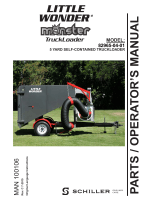 Little Wonder 82965-04-01 Owner's manual
Little Wonder 82965-04-01 Owner's manual
-
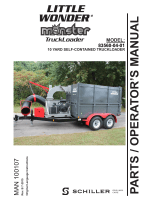 Little Wonder 83560-04-01 Owner's manual
Little Wonder 83560-04-01 Owner's manual
-
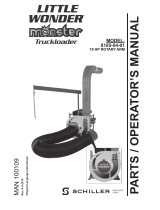 Little Wonder 8185-04-01 Owner's manual
Little Wonder 8185-04-01 Owner's manual
-
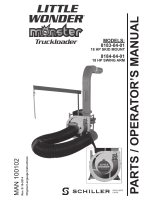 Little Wonder 8183-04-01, 8184-04-01 Owner's manual
Little Wonder 8183-04-01, 8184-04-01 Owner's manual
-
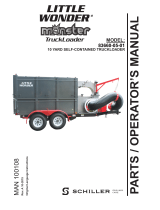 Little Wonder 83660-05-01 Owner's manual
Little Wonder 83660-05-01 Owner's manual
-
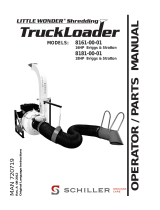 Little Wonder 8181 Owner's manual
Little Wonder 8181 Owner's manual
-
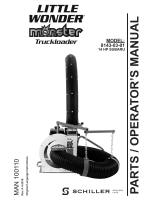 Little Wonder 8143-03-01 Owner's manual
Little Wonder 8143-03-01 Owner's manual
-
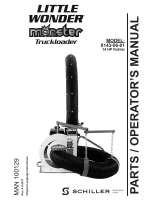 Little Wonder 8143-06-01 Owner's manual
Little Wonder 8143-06-01 Owner's manual
-
 Little Wonder 8141 Owner's manual
Little Wonder 8141 Owner's manual
-
Little Wonder Shredding TruckLoader 8221 User manual
Other documents
-
Lifetime Yard Vacuum 115 User manual
-
Bluebird BH270 Operating instructions
-
RetroSound Wonder Bar® 3 Quick start guide
-
Reese Towpower 51054 Installation guide
-
Billy Goat HTR1803VEU User manual
-
Billy Goat QL2000VE User manual
-
Simplicity DEBRIS UNITS User manual
-
Billy Goat QL2300KOEU User manual
-
Simplicity GIANT-VAC ASSEMBLY INSTRUCTIONS OPERATOR'S MANUAL PARTS LIST 29HP TRUCK LOADER WITH CHIPPER User manual
-
Billy Goat TR1103 User manual
































